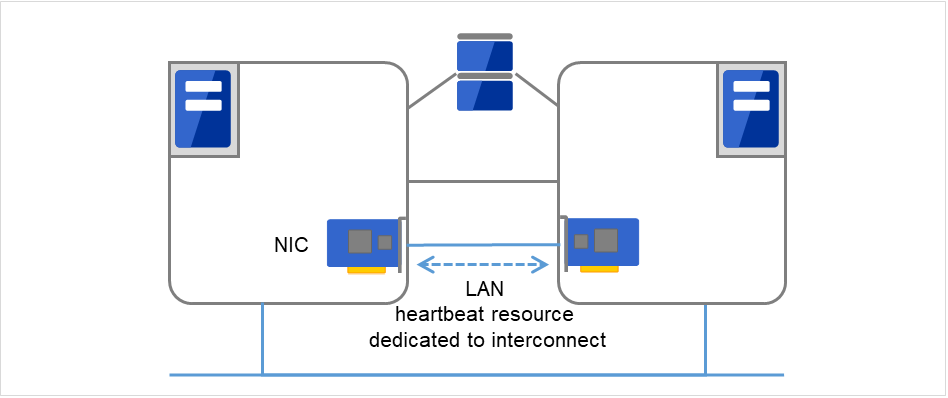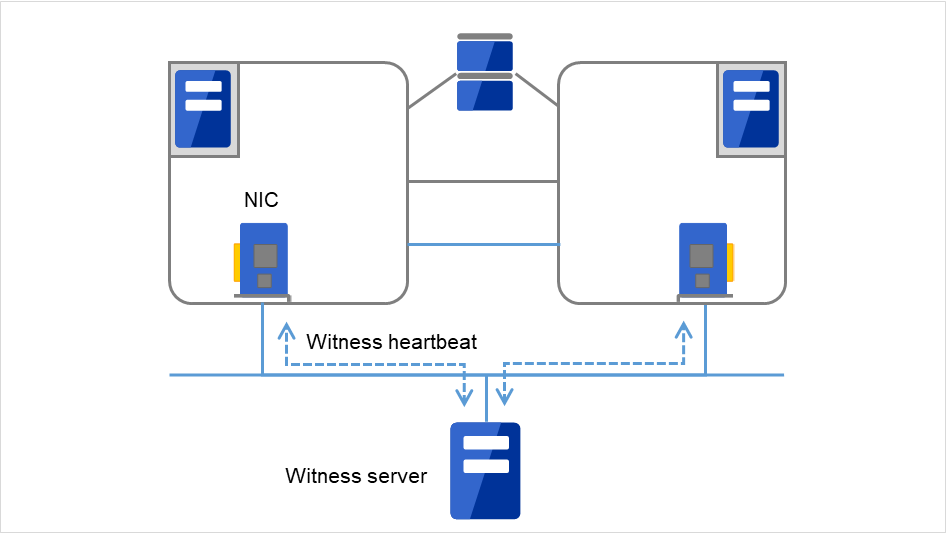5. Heartbeat resources¶
This chapter provides detailed information on heartbeat resources.
This chapter covers:
5.1. Heartbeat resources¶
Servers in a cluster monitor if other servers in the cluster are activated. For this monitoring, heartbeat resources are used.
LAN heartbeat/kernel mode LAN heartbeat (primary interconnect)

Fig. 5.1 LAN heartbeat/kernel mode LAN heartbeat (primary interconnect)¶
LAN heartbeat/kernel mode LAN heartbeat (secondary interconnect)

Fig. 5.2 LAN heartbeat/kernel mode LAN heartbeat (secondary interconnect)¶
BMC heartbeat

Fig. 5.3 BMC heartbeat¶
Witness heartbeat

Fig. 5.4 Witness heartbeat¶
Type of Heartbeat resource |
Abbreviation |
Functional overview |
|---|---|---|
Kernel mode LAN heartbeat resource (1), (2) |
lankhb |
A kernel mode module uses a LAN to monitor if servers are activated. |
BMC heartbeat resource (3) |
bmchb |
Monitors if servers are activated by using BMC. |
Witness heartbeat resource (4) |
witnesshb |
A module uses the Witness server to monitor whether or not servers are active. |
- You need to set at least one LAN heartbeat resource. It is recommended to set two or more LAN heartbeat resources.It is recommended to set both interconnect-dedicated LAN heartbeat resource and public LAN heartbeat resource together.
Make sure to set one or more Kernel mode LAN heartbeats that can communicate among all the servers.
5.2. Understanding kernel mode LAN heartbeat resources¶
5.2.1. Kernel mode LAN heartbeat resources¶
Kernel mode LAN heartbeat resources achieve heartbeat functions using the kernel mode driver module. Kernel mode LAN heartbeat resources are less burdened and help to reduce misidentification of disconnection of interconnect by using the kernel mode driver.
5.2.2. Settings of the kernel mode LAN heartbeat resources¶
For details on settings of the kernel mode LAN heartbeat resources, see "Interconnect tab" in "Cluster properties" in "2. Parameter details" in this guide.
5.2.3. Notes on the kernel mode LAN heartbeat resources¶
It is recommended to specify two or more kernel mode LAN heartbeat resources; the one dedicated to interconnect and the one shared with interconnect and public.
5.3. Understanding BMC heartbeat resources¶
5.3.1. Notes on BMC heartbeat resources¶
BMC heartbeat resources provide the same functions as LAN heartbeat resources using the BMC. They have the following features:
BMC heartbeat resources are less burdened and help to reduce the misidentification of any disconnection of an interconnect by using hardware to monitor whether the server is active.
The versions of the BMC hardware and firmware must be available for BMC heartbeat resources. For the available BMC versions, refer to "Servers supporting Express5800/A1080a or Express5800/A1040a series linkage" in "Installation requirements for EXPRESSCLUSTER" in the "Getting Started Guide".
5.4. Understanding Witness heartbeat resources¶
5.4.1. Settings of the Witness heartbeat resources¶
To use the Witness heartbeat resources, the following settings are required.
The communication needs to be available between all the servers using Witness heartbeat resources and the server where the Witness server service operates (Witness server). For the Witness server, refer to "Witness server service" in "7. Information on other settings".
The Witness heartbeat resources allow to regularly check the server alive information which the Witness server retains. The server alive information is consolidated, which prevents discrepancies with alive information between servers from easily occurring. In addition, by using the HTTP network partition resolution resource as well, "communication disconnection between a local server and Witness server" and "communication disconnection between other servers and Witness server" are distinguished while the Witness heartbeat resources are operated.
5.4.2. Notes on the Witness heartbeat resources¶
In the communication with the Witness server, NIC and a source address are selected according to the OS settings.